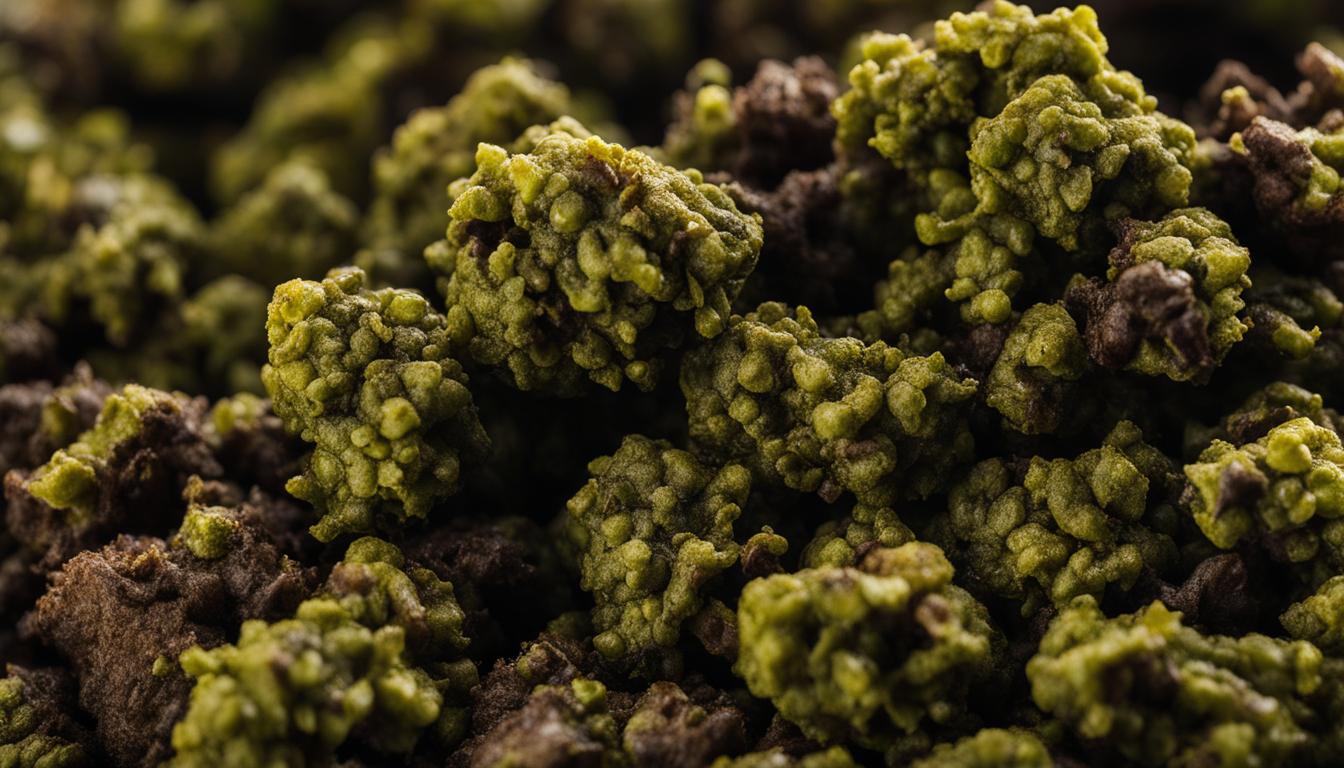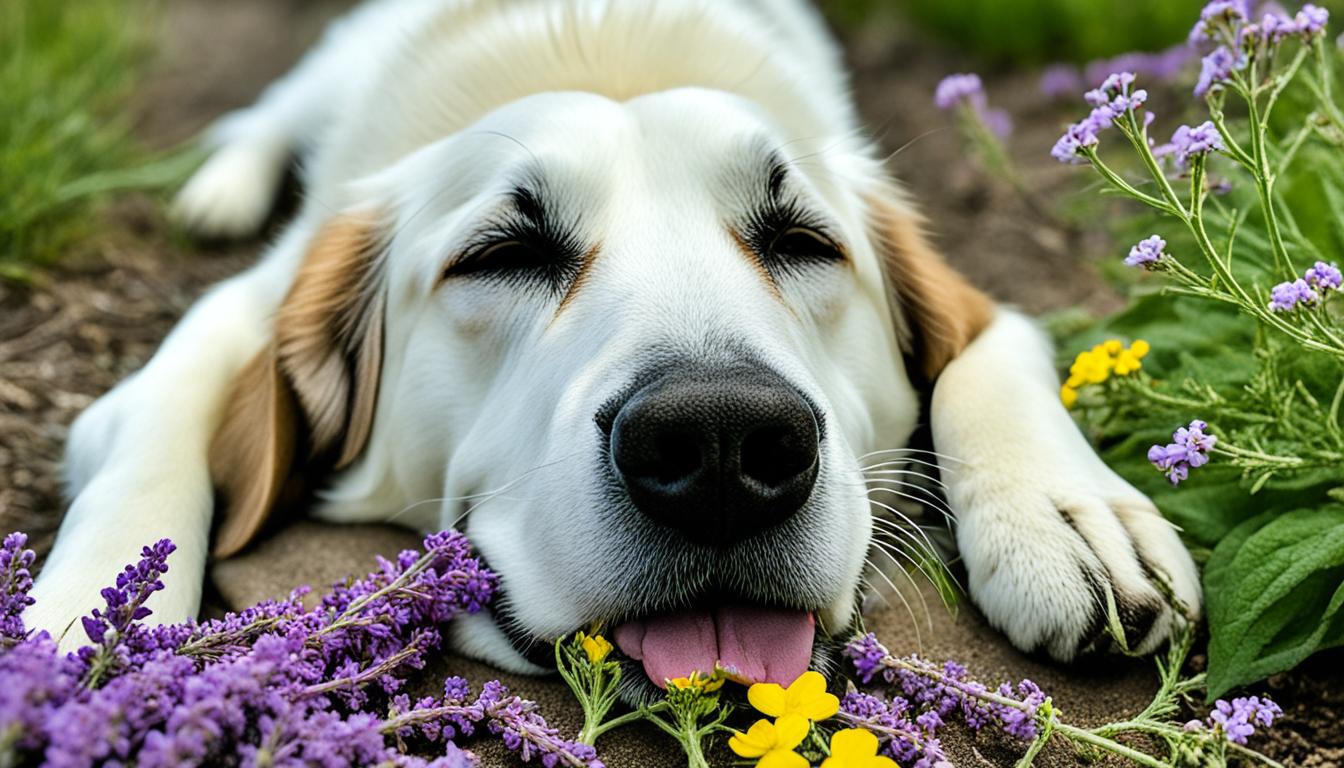Dogs can face dental problems just like humans. They may get cavities, gum disease, broken teeth, and even abscesses or cysts. Gum disease is the most frequent issue found in dogs older than 31. Recognizing and fixing dental problems early is crucial. This helps avoid serious issues later on. Trained vets or dental specialists should do these procedures. This includes cleaning, scaling, pulling teeth, and fixing them.
Key Takeaways:
- Periodontal disease is the most common dental issue in dogs over the age of 3.
- Early detection and treatment of dental problems are crucial in preventing severe issues.
- Veterinary dentistry should be performed by professionals to ensure proper care.
Causes of Dental Problems in Dogs
Dogs can face dental issues due to broken teeth, infections, and more.1 Periodontal disease is a big issue. It happens when plaque builds up, leading to gum inflammation and damage.1 If not treated, it might hurt the kidneys, liver, or heart. Regular cleanings and early treatment are key. They keep dogs’ teeth healthy.
Plaque turns into tartar if not cleaned off in two days.2 Tartar harms teeth and gums, possibly causing tooth loss and disease.2 Red, swollen gums suggest gingivitis, a red flag for dental troubles. Brushing their teeth regularly helps avoid these problems.2 Also, yearly dental check-ups are vital for good dental health and finding any hidden problems.2
Chewing hard things can break dogs’ teeth.2 These fractures might need tooth removal or other treatments. Mouth injuries can lead to infections.2 Keeping up with dental care and check-ups helps prevent these issues from getting worse. Also, periodontal disease must be treated early to protect the teeth.2
It’s crucial for owners to know what causes dental problems in dogs. Taking action to prevent and treat these issues is important. Doing so helps dogs live a healthier, happier life.
Treatment of Dental Issues in Dogs
When treating dental issues in dogs, the method varies based on the issue’s seriousness and type. The main aim is to fix the problem and boost the dog’s oral health and happiness.
Dental cleanings, scaling, and polishing are key for fighting early gum disease. They get rid of plaque, tartar, and germs from a dog’s teeth and gums. This stops further harm and helps healing. To keep their mouths healthy and stop more serious diseases, dogs need regular dental care. Small dogs should have their first cleaning by age 2, and large dogs by age 3.1
If a dog has severe gum disease with a lot of bone loss, tooth extraction might be needed. Taking out badly-damaged teeth stops infection and pain, protecting nearby tissues and bones. Dogs are put under anesthesia for this, making sure they’re comfortable and safe.1
For cracked teeth, root canals are one option. This process takes out damaged pulp and fills the space with a dental material. It saves the tooth’s structure and stops pain and infection. Yet, not every cracked tooth can be saved this way, and sometimes removal is the only choice.1
Dogs sometimes have malocclusions, or teeth and jaw misalignments. To fix this, vets might suggest orthodontic work or pulling teeth. Specialists provide tailored treatment based on the dog’s specific issues. It’s essential to get expert advice for the best care.1
Designing a treatment plan that fits the dental issue’s severity and aims is key for good results in dog dental care. Teaming up with a vet or a vet dentist ensures the dog gets the best, most fitting treatment. This improves their oral health and life quality.
Prevention of Dental Issues in Dogs
To keep your dog’s teeth healthy, start dental care early. A daily routine of tooth brushing is best. It lowers the chance of your dog having dental problems.3
When teaching your dog to brush, be patient. Start with tools made just for dogs, since human ones can hurt them. Use a gentle, circular motion to clean all tooth surfaces. Brushing regularly takes away plaque and stops tartar.3
Dental chews are also great for your dog’s teeth. They help fight plaque and tartar. Make sure to choose chews that fit your dog’s age and size.4
Your dog also needs check-ups at the vet. These visits can catch dental problems early and include professional cleanings. Since most dogs have dental issues by age three, these check-ups are very important.3
Not every dental product is good. The Veterinary Oral Health Council checks if dental products work well. Look for their seal to know you’re getting a quality product.3
A good dental care plan includes brushing, the right products, and vet visits. This can stop dental problems before they start. Prevention is key to your dog’s dental health.4
Anesthesia in Veterinary Dentistry
Anesthesia is key for dog dental procedures. It helps keep pets and vets safe during the process. By reducing stress and pain, it ensures a detailed dental exam and cleaning. This gives dogs better oral health care. Also, it helps get clearer images with radiographs, important for diagnosing and treating dental problems. Plus, it lessens the chance of getting hurt by dental tools. With today’s veterinary advances, anesthesia is safer, with many protocols to reduce risks5.
Anesthesia’s benefits are greater than its risks in dentistry for dogs. It stops pain and infection that dental diseases can cause. This pain hurts dogs’ quality of life. With anesthesia, dogs don’t feel pain during dental work. It’s important to follow the right anesthesia steps to keep pets safe. This means checking their health before anesthesia and watching them closely during it. This helps find and fix any problems quickly5.
Dental nerve blocks are a big help in vet dentistry, too. They stop pain in oral surgery, allowing for less anesthesia. Because they target certain nerves, these blocks manage pain well. This makes the dental work safer and more effective5.
Getting dental care early can mean less anesthesia and fewer risks. Regular cleanings and check-ups keep dogs’ teeth healthy. This avoids the need for bigger procedures later. So, starting dental care early is good for dogs’ long-term health5.
Even though anesthesia has its risks, it’s very beneficial in vet dentistry. Most dogs can go home the same day they have a procedure. This lets them recover in a place they know and like. Vets work hard to make sure anesthesia is safe. They follow strict rules to make dental visits easy for dogs and their owners5.
Home Care for Dog’s Oral Health
Keeping your dog’s teeth clean at home is key for good oral health. It’s best to brush their teeth 2-3 times a week or daily if possible6. This gets rid of plaque and stops tartar buildup. Brushing also keeps their gums healthy.
Choose the right dental products for your dog’s teeth. There are special toothpastes and toothbrushes just for dogs. Also, look for dental treats and foods proven to fight dental disease, like Purina ProPlan and Hill’s Prescription Diet6. The Veterinary Oral Health Council gives a seal to products that really fight tartar6.
Always ask a vet about what dental products are best for your dog. They know what’s needed based on your dog’s health and breed. Dogs also need their teeth cleaned by vets sometimes, the frequency depends on the dog6.
Watch out for signs of dental problems in your dog. These can be bad breath, trouble eating, or swollen face7. If you see these signs, go to a vet. Getting regular dental checks helps catch problems early7.
Chewing is also great for your dog’s teeth as it helps fight plaque and tartar. But, be careful with hard objects to avoid tooth damage. Other options include dental diets and chews7.
After a vet cleans your dog’s teeth, keep up the care at home7. Regular brushing and using the right dental products can make a big difference in your dog’s dental health.
Common Dental Issues in Dogs
Dogs face several dental issues, including inflammation of the gums (gingivitis), periodontal disease, and tooth fractures. These problems can hurt a dog’s mouth health and overall happiness.
Gingivitis in dogs is when the gums get inflamed. This is usually because plaque and tartar build up on the teeth. If not treated, it can lead to serious gum disease, hurting the teeth’s support system.
Over 80% of dogs over the age of three have active dental disease.3
Periodontal disease in dogs is a common issue that impacts the tissues around the teeth. It begins with gum inflammation and can damage the tissue and bone, making teeth loose or leading to their loss.
It is estimated that more than two-thirds of dogs over three years old suffer from some degree of periodontal disease.3
Tooth fractures in dogs happen often. They’re usually the result of chewing hard items like ice or bones. These fractures can expose the inside of the tooth, causing pain, infection, and other problems.
Most tooth fractures in dogs occur when chewing on hard objects like ice cubes or bones.3
Taking care of your dog’s teeth is key. Regular brushing, professional cleanings, and certain diets can prevent or treat these dental problems.
Prevention and Treatment
To stop gingivitis and periodontal disease, proper teeth care is essential. Yet, most dog owners don’t brush their pet’s teeth every day.
Most dog owners do not brush their dog’s teeth daily, even though it is the best form of plaque control.3
Dental diets created by pet food companies can also reduce plaque and tartar. These special diets help improve mouth health and are good for your dog’s teeth.
Dental diets developed by pet food manufacturers can help reduce plaque and tartar formation.3
Once tartar is there, professional cleaning under anesthesia might be necessary. This procedure removes tartar and gets teeth healthy again.
Professional scaling and polishing under general anesthesia is needed once tartar has formed.3
A full general anesthetic is required for dental cleanings in dogs.3
If a tooth is fractured, removing the tooth or a root canal could be needed. This is especially true if the tooth’s pulp is exposed.
Extraction of the tooth or a root canal may be necessary if a dog’s tooth is fractured with exposure to the pulp.3
Preventive Measures and Early Detection
To avoid dental problems, regular dental check-ups are important. Small dogs and those with short noses are more likely to get gum disease. Finding and treating issues early is crucial.
Small breeds and brachycephalics (short-nosed dogs) are more prone to periodontal disease.3
Dental cleanings and exams should start early. Small dogs should get their first cleaning by age 2, and large dogs by age 3.
Small dogs should have their first dental cleaning by age 2, and large dogs by the age of 3.1
Regular dental care is a big part of preventing disease. Brushing teeth, eating right, using dental chews, and adding to water all help keep teeth healthy. It’s important to care for your pet’s oral health for a better, happier life.
Dental disease is preventable with routine dental care, including toothbrushing, dental diets, chews, and water additives.1
By knowing about these dental problems and how to prevent them, pet owners can keep their dogs’ mouths healthy. This helps ensure a happy life for our furry friends.
Dental Terms and Definitions
Knowing dental terms helps talk and learn about dog dental health. It lets us understand and explain problems better when we talk to vets. This way, we can catch dental problems in our pets early.
Gingivitis
Gingivitis is when a dog’s gums get swollen, usually from too much plaque and tartar. It’s the first step toward1periodontal disease. Without treatment, it can get worse and lead to more serious dental problems.
Periodontal Disease
Periodontal disease is a common problem for dogs. It hurts the areas around their teeth. Signs include plaque, tartar buildup, swollen gums, bad breath, and tooth loss if ignored.1Doctors grade it from 0 (okay) to 4 (very bad) based on how serious it is.
Tartar
Tartar, or dental calculus, is plaque that has gotten hard on teeth. You can’t get rid of it just by brushing. It needs a vet to clean it off so it doesn’t cause more dental issues.1
Plaque Buildup
Plaque is a sticky layer that builds up from bacteria, food, and saliva. Without regular cleaning, like brushing, it turns into tartar. This can lead to gum disease.1
Tooth Fractures
Teeth in dogs can break from injuries or biting hard things. These breaks can hurt and might need a dentist to fix or remove them.8 The treatment depends on how bad the break is and where it is.
Malocclusions
Malocclusions are when teeth or jaws don’t line up right. They can make it hard for dogs to eat or cause pain. Dogs might need braces or teeth pulled to fix it.1
Triadan System
The Triadan system helps vets talk about dogs’ teeth. It’s a standard way to name and number them. Knowing this system helps with correct diagnosis and treatment plans.9
Deciduous and Permanent Teeth
Dogs have baby teeth, called deciduous teeth, that fall out as they grow. Then, they get their adult teeth. Knowing the difference is key for keeping track of dental health.9
Additional Dental Disorders
Dogs can also suffer from abscesses, cysts, tumors, and palate problems. These issues might need surgery. It’s important to treat them to prevent bigger health problems.9
Conclusion
Good dental health is key for a dog’s overall happiness. Issues like plaque, tartar, and bad breath can lessen their life quality.10 Regular check-ups and cleaning at home are vital for avoiding these dental problems.10 Owners should know certain breeds like Dachshunds and Boxers might have more teeth troubles and need extra care.10
Professional teeth cleanings for dogs usually cost between $300 and $700, not counting extra treatments.10 Brushing your dog’s teeth daily keeps their mouth healthy.10 Natural treats like yak chews help with plaque and tartar. Dogs must never use human toothpaste because it can be toxic to them.10
Over 80% of dogs over three have periodontal disease.11 A survey shows an owner’s view on their dog’s dental health changes with the dog’s age, breed, and health.11 Even though daily brushing is advised, not all owners do it. The survey also found about one in eight dogs had dental cleaning under anesthesia, showing the need to address dental issues quickly.11
Dental health is super important for dogs. Regular care and catching problems early help dogs stay happy and pain-free.1011 By following these steps, you can make sure your furry friends enjoy good dental health throughout their lives.
FAQ
What are the common dental problems in dogs?
What is periodontal disease, and why is it a common dental issue in dogs?
What treatments are available for dental issues in dogs?
How can dental problems in dogs be prevented?
Is anesthesia necessary for dental procedures in dogs?
What can I do at home to maintain my dog’s oral health?
What are some common dental issues in dogs?
What are some dental terms and definitions that dog owners should be familiar with?
Source Links
- https://www.petmd.com/dog/conditions/mouth/dental-issues-dogs
- https://www.allpetsvh.com/site/blog/2023/01/15/teeth-problems–dental-disease-dogs
- https://vcahospitals.com/know-your-pet/dental-disease-in-dogs
- https://www.whimzees.com/blog/5-ways-to-prevent-dental-disease-in-your-dog/
- https://mainelyvetdentistry.com/anesthesia-and-veterinary-dentistry/
- https://www.petmd.com/dog/general-health/dog-dental-care-6-ways-keep-dogs-mouth-clean
- https://www.vet.cornell.edu/departments-centers-and-institutes/riney-canine-health-center/canine-health-information/dental-disease-and-home-dental-care
- https://www.avma.org/resources-tools/pet-owners/petcare/pet-dental-care
- https://avdc.org/avdc-nomenclature/
- https://tibetandogchew.com/blogs/blog/common-dental-problems-in-dogs
- https://www.ncbi.nlm.nih.gov/pmc/articles/PMC7297050/








